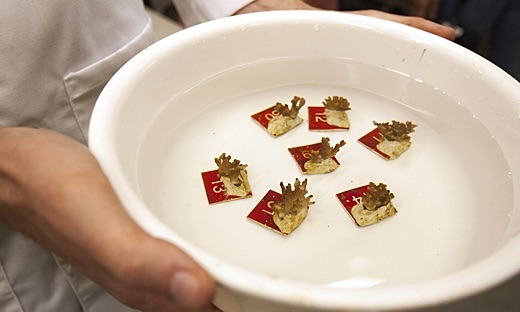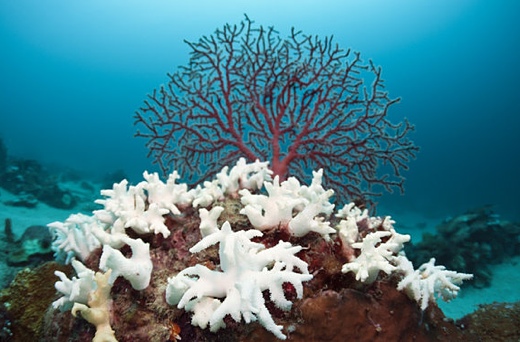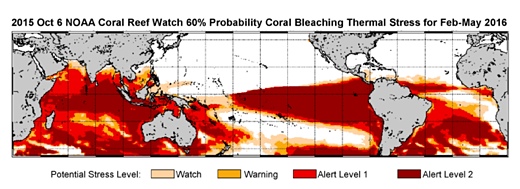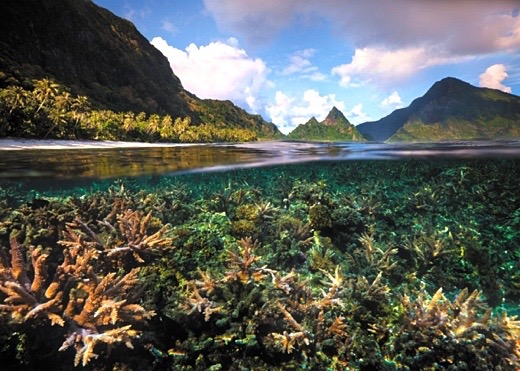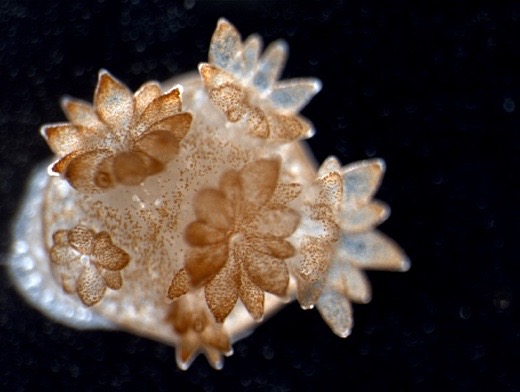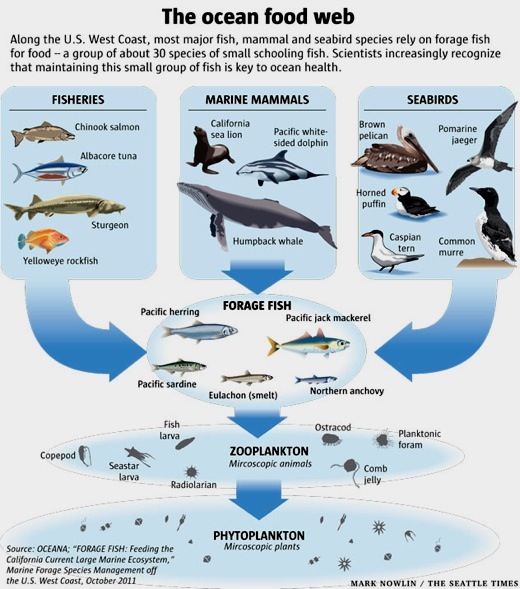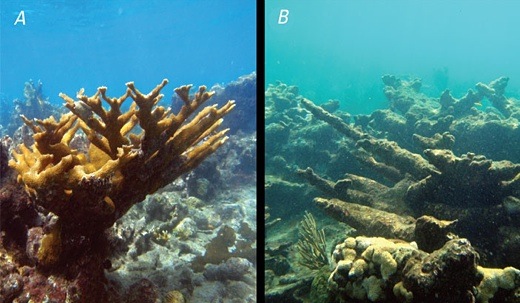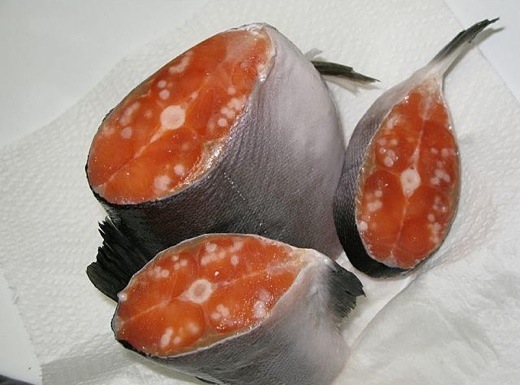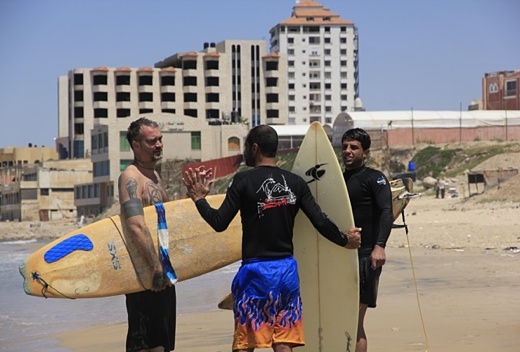SUBHEAD: Resistance gives ultimate meaning to life in the Anthropocene. Let’s embrace it, and each other.
By John Foran on 16 November 2017 for Resilience -
(http://www.resilience.org/stories/2017-11-16/abrupt-climate-justice/)

Image above: Photograph of dawn as Somali woman walks through a camp of people displaced from their homes by the drought in Qardho, Somalia, March 9, 2017. From (https://www.voanews.com/a/dire-food-insecurity-five-east-african-countries-facing-drought/3944455.html).
Three of the most intense hurricanes ever recorded just ripped through Puerto Rico and the southern US – within weeks of each other! Ash rained from the sky in Seattle and Portland for weeks. Record monsoons swept through Asia. Parts of Sierra Leone and Niger are underwater. San Francisco recorded its hottest day ever and Europe endured a triple-digit heat wave they called “Diablo.”
The fucking devil is here man, and its name is climate change. – Wendy & Jesse & Hayley & Teresa, “Face Down Climate Change,” Slingshot issue 125 (Autumn 2017)
I recently attended a talk by Guy McPherson, generally acknowledged as the doyen –some consider him the “superhero” – of the abrupt climate change [ACC] thesis [note to readers: I understand that Guy McPherson can be a “polarizing” figure for some in the Resilience community; I ask only that you read my essay with the usual care, and stay focused on the nuances of my argument!).
I only came across this debate because I met – to my great good fortune – Shanelle LeFage, a millennial expert on it, and have subsequently followed her leads into the literature, discussed below. As I learned more, I began to realize something that I had always intimated: the science is grimmer than any of us know…
This has important implications for how those of us in the global climate justice movement approach our work, that it’s high time we tease out and engage with.
The Science of Abrupt Climate Change
The science is new, not widely known, and even less widely accepted. In shorthand form, it connects these dots:
Robert Hunziker, another excellent climate journalist who is covering the story, quotes Oxford University researcher Peter Wadhams, author of the recently released A Farewell to Ice:
The scientists in the Arctic Methane Emergency Group, the Russian team of Natalia Shakhova and Igor Semilitev of the University of Alaska-based International Arctic Research Center, along with Leifer and others, are extremely concerned that the amounts could be significant. And remember, methane’s warming potential as a greenhouse gas is many times greater than carbon dioxide, its better known cousin.
While it’s true that methane’s warming effect wears off in a matter of decades, as opposed to centuries for CO2, the last thing that humanity needs at this point in the twenty-first century – at the very dawn of the Anthropocene and the halting first steps by the international community to come to terms with the climate crisis, however ineffectually – the last thing that humanity needs now is a single to several degree spike in average temperatures, which would accelerate ocean acidification, glacier and ice melt, rising oceans, and the “extreme” (now proven to be a polite word) weather that has started to beset us with alarming regularity. Oh, wait, that’s already happening, so this would all be intensified.
As Robert Hunziker notes, it may be that:
We should therefore be asking some “what if” questions. What if a sudden burst of methane led to a collapse or serious disruption of industrial society? Apocalypse then? Dystopia in our lifetimes, anyone?
Since we can’t answer this question, the stakes couldn’t be higher. Repeat: the stakes could not be higher. No one tells the disheartening story of the implications of abrupt climate change better than Guy McPherson, Professor Emeritus of Natural Resources and Ecology and Evolutionary Biology at the University of Arizona, who walked away from his life as a tenured teacher when colleagues and administrators found his message (and his anarchist pedagogy) too disturbing for the undergraduates he so openly and creatively tried to explore this with.
McPherson then spent seven years in the arid landscape of New Mexico, learning the difficult arts of homesteading, self-sufficiency, and community-building with an assortment of like-minded spirits before packing that in and moving to Belize (a rather hot spot for a climate “doomist,” as he is often accused of being), where he now runs workshops for people whose lives have been shattered by their reading of the crisis as a terminal, near-term one for civilization.
As Dahr Jamail, the leading investigative journalist of abrupt climate change puts it:
I have no firm position in this debate, other than to take seriously the general line of argument that follows from the ice-free Arctic to the possibility of a severe and sudden disruption of our climate system’s ongoing dysfunction.
Abrupt Climate Justice
Our first responsibility remains, as always, to tell the truth. The debate that exploded in climate circles this summer over the widely-read essay, “The Uninhabitable Earth,” by David Wallace-Wells in New York magazine, touched a nerve, and it was fascinating to see such eminent climate scientists as Michael Mann react to its harsh thesis, while activists such as Margaret Klein Salamon of the Climate Mobilization and journalists such as Dave Roberts at Vox generally found it worth taking on board.
All Wallace-Wells did was report what leading scientists think will happen in the worst-case scenario of continued business as usual (BAU).
We need to take a similar hard look at the situation now, in light of the possibility of abrupt climate change – however remote, and remember it’s anyone’s SWAG as to the precise likelihood, possibility, or probability, and even more of a SWAG to suggest when (or if) and how much of a temperature spike might hit us.
So please don’t misread my views as anything more than acknowledging the possibility of yet another worst-case (actually a worse case) scenario. It just turns out that Wallace-Wells may have erred on the optimistic side. Yikes!
Speaking now as a social scientist and scholar-activist, here are some of the things (I think) we know.
In the global climate justice movement, we know that BAU neoliberal global capitalism is already a slow-fuse death sentence for humanity. The best science, such as that of Kevin Anderson, established this almost ten years ago.
We know that our only hope is the global climate justice movement. I can hear friends like Shanelle over my shoulder saying “But there is no hope!”
But with other heroes of mine, from Bill McKibben (in all of his work, including a new novel, Radio Free Vermont) to Naomi Klein (in This Changes Everything and No Is Not Enough) to Rebecca Solnit (in Hope in the Dark and countless exquisite essays), I remain a deeply serious and (fun-) loving “hopist.”
And aren’t referring (or at least I’m not) to a kind of false hope that we can really contain the climate crisis from taking humanity into extremely dangerous climate change.
What we mean is real(istic) hope for deep, radical social transformation as the crisis unfolds. This is what we are fighting for, and if you don’t think that overthrowing capitalism and the one percent is worth fighting for … then don’t join us. Except, I suspect that increasing numbers of readers could be on board for this.
We already knew that time is short: Carbon Brief’s meticulous carbon budgets tell us that we have perhaps four years of current-level GHG emissions left before we pass 1.5 degrees Celsius of warming.
Geoengineering – risky, untested, capitalist wishful thinking – is about to be (or is already being) foisted on us for effectively allowing two degrees to become a fait accompli, thus dictating that we somehow develop the capacity to remove already released greenhouse gases from the air.
So now, the existential urgency of our politics has just been accelerated by the possibility of abrupt climate change, or at the very least, the knowledge that tipping points, positive feedback loops, and so much more that is not in the IPCC’s climate models and future scenarios is on the cards.
We have to be clear about this: we probably can’t prevent the climate from deteriorating toward a nearly uninhabitable Earth.
Does this mean have to do things differently? Well, since we aren’t winning at present, that would probably be a good idea. We need new ideas, fresh voices, radical imaginations, and loving hearts, still and always.
To address abrupt climate change as a possibility and extremely dangerous climate change as a certainty, we might want to adjust and re-imagine our work as abrupt climate justice. This is not just for me to do, but here are a few starters that I have been thinking about recently…
Such a “party” (and the name is apt for the convivial connotations it holds) will be the patient, challenging, loving product of the actions of many people, and it will embrace the multiple, richly diverse threads of the new political cultures of opposition and creation that are bubbling up from the recesses of our wildest imaginations.
What if we could harness the people power, radical imagination, and boundless energy of all of these new actors in the present and the future, starting to facilitate discussions among the new social movements, brainstorming how to fashion some new kind of party to take power where that is possible while beginning or continuing to support and enable all the emerging transition initiatives to co-create radical social transformation on every level, from the always available local to the much needed national, not to mention our global arenas of struggle?
What have we got to lose? We aren’t winning at present. We need to try something different, something, really, that we haven’t tried before.
As Nathan Thanki, a young Irish climate justice radical has said in his trenchant response to the Wallace-Wells controversy, “Fuck Your Apocalypse”:
Resistance gives ultimate meaning to life in the Anthropocene. Let’s embrace it, and each other. And let’s move forward now, with urgency, with or without hope!
.
By John Foran on 16 November 2017 for Resilience -
(http://www.resilience.org/stories/2017-11-16/abrupt-climate-justice/)

Image above: Photograph of dawn as Somali woman walks through a camp of people displaced from their homes by the drought in Qardho, Somalia, March 9, 2017. From (https://www.voanews.com/a/dire-food-insecurity-five-east-african-countries-facing-drought/3944455.html).
Three of the most intense hurricanes ever recorded just ripped through Puerto Rico and the southern US – within weeks of each other! Ash rained from the sky in Seattle and Portland for weeks. Record monsoons swept through Asia. Parts of Sierra Leone and Niger are underwater. San Francisco recorded its hottest day ever and Europe endured a triple-digit heat wave they called “Diablo.”
The fucking devil is here man, and its name is climate change. – Wendy & Jesse & Hayley & Teresa, “Face Down Climate Change,” Slingshot issue 125 (Autumn 2017)
I recently attended a talk by Guy McPherson, generally acknowledged as the doyen –some consider him the “superhero” – of the abrupt climate change [ACC] thesis [note to readers: I understand that Guy McPherson can be a “polarizing” figure for some in the Resilience community; I ask only that you read my essay with the usual care, and stay focused on the nuances of my argument!).
I only came across this debate because I met – to my great good fortune – Shanelle LeFage, a millennial expert on it, and have subsequently followed her leads into the literature, discussed below. As I learned more, I began to realize something that I had always intimated: the science is grimmer than any of us know…
This has important implications for how those of us in the global climate justice movement approach our work, that it’s high time we tease out and engage with.
The Science of Abrupt Climate Change
The science is new, not widely known, and even less widely accepted. In shorthand form, it connects these dots:
- We are on the verge of an “ice-free” Arctic, or a so-called “blue ocean event,” meaning that, at the end of the summer months in the northern hemisphere, ocean waters have warmed to the point where there is nearly no ice left in the Arctic Ocean except in secluded enclaves.
- This leads to even more warming because of the loss of the reflectivity of the ice, the so-called albedo effect.
- Now we have the first of many positive feedback loops – less ice, warmer air, warmer water, less ice.
- As the northern ocean warms further, the risk increases of the release into the atmosphere of both methane clathrates (methane deposits that have been kept on the ocean floor because they have till now been “frozen” in the slush) and of methane on northern lands as permafrost warms and melts.
- And, of course, this all comes with the attendant feedback loops: more extreme weather events and all the rest – rising seas, changing ocean currents, warmer weather and oceans, ad infinitum, literally and unfortunately.
Moving beneath the Arctic Ocean where methane hydrates – often described as methane gas surrounded by ice – exist, a March 2010 report in Science indicated that these cumulatively contain the equivalent of 1,000-10,000 gigatons of carbon. Compare this total to the 240 gigatons of carbon humanity has emitted into the atmosphere since the industrial revolution began.Dahr Jamail’s book, The End of Ice, is promised for 2018.
A study published in the prestigious journal Nature this July suggested that a 50-gigaton “burp” of methane from thawing Arctic permafrost beneath the East Siberian sea is “highly possible at any time.” That would be the equivalent of at least 1,000 gigatons of carbon dioxide.
Even the relatively staid IPCC has warned of such a scenario: “The possibility of abrupt climate change and/or abrupt changes in the earth system triggered by climate change, with potentially catastrophic consequences, cannot be ruled out. Positive feedback from warming may cause the release of carbon or methane from the terrestrial biosphere and oceans.”
Robert Hunziker, another excellent climate journalist who is covering the story, quotes Oxford University researcher Peter Wadhams, author of the recently released A Farewell to Ice:
Leading researchers, like Peter Wadhams, professor of Ocean Physics and Head of the Polar Ocean Physics Group, Department of Applied Mathematics and Theoretical Physics, University of Cambridge for years have repeatedly warned, over and over again, the day will come when the Arctic will be ice-free.From here, all bets would be off. How much methane could be released is the subject of at best a SWAG – “scientific wild-assed guess” – according to methane specialist Ira Leifer, whom Shanelle and I spoke with in Santa Barbara in September.
That’s when bright red flashing lights and sirens start going off, as the water will be absorbing all but 6% of sunlight. Whereas with its icy cover, the Arctic reflects up to 90% of sunlight back to space, no harm, no foul.
When Dr. Wadhams was asked in an interview if “civilization could withstand a 50-gigaton release of methane,” he answered: “No, I don’t think it can.”
The scientists in the Arctic Methane Emergency Group, the Russian team of Natalia Shakhova and Igor Semilitev of the University of Alaska-based International Arctic Research Center, along with Leifer and others, are extremely concerned that the amounts could be significant. And remember, methane’s warming potential as a greenhouse gas is many times greater than carbon dioxide, its better known cousin.
While it’s true that methane’s warming effect wears off in a matter of decades, as opposed to centuries for CO2, the last thing that humanity needs at this point in the twenty-first century – at the very dawn of the Anthropocene and the halting first steps by the international community to come to terms with the climate crisis, however ineffectually – the last thing that humanity needs now is a single to several degree spike in average temperatures, which would accelerate ocean acidification, glacier and ice melt, rising oceans, and the “extreme” (now proven to be a polite word) weather that has started to beset us with alarming regularity. Oh, wait, that’s already happening, so this would all be intensified.
As Robert Hunziker notes, it may be that:
“The only question going forward is whether climate change rapidly accelerates as an out of control defiant monster or evolves little by little, in which case the gradualists will be correct, meaning future generations can fight the demons of ecosystem collapse.”The Stakes when We Connect the Dots
We should therefore be asking some “what if” questions. What if a sudden burst of methane led to a collapse or serious disruption of industrial society? Apocalypse then? Dystopia in our lifetimes, anyone?
Since we can’t answer this question, the stakes couldn’t be higher. Repeat: the stakes could not be higher. No one tells the disheartening story of the implications of abrupt climate change better than Guy McPherson, Professor Emeritus of Natural Resources and Ecology and Evolutionary Biology at the University of Arizona, who walked away from his life as a tenured teacher when colleagues and administrators found his message (and his anarchist pedagogy) too disturbing for the undergraduates he so openly and creatively tried to explore this with.
McPherson then spent seven years in the arid landscape of New Mexico, learning the difficult arts of homesteading, self-sufficiency, and community-building with an assortment of like-minded spirits before packing that in and moving to Belize (a rather hot spot for a climate “doomist,” as he is often accused of being), where he now runs workshops for people whose lives have been shattered by their reading of the crisis as a terminal, near-term one for civilization.
As Dahr Jamail, the leading investigative journalist of abrupt climate change puts it:
Not surprisingly, scientists with such views are often not the most popular guys in the global room. McPherson, for instance, has often been labeled “Guy McStinction” – to which he responds, “I’m just reporting the results from other scientists. Nearly all of these results are published in established, esteemed literature.And it is true that McPherson has met with fierce criticism from many well-placed climate scientists, as for example, this broad-ranging dismissal by Scott Johnson at Fractal Planet.
I don’t think anybody is taking issue with NASA, or Nature, or Science, or the Proceedings of the National Academy of Sciences. [Those] and the others I report are reasonably well known and come from legitimate sources, like NOAA [the National Oceanic and Atmospheric Administration], for example. I’m not making this information up, I’m just connecting a couple of dots, and it’s something many people have difficulty with.”
McPherson does not hold out much hope for the future, nor for a governmental willingness to make anything close to the radical changes that would be necessary to quickly ease the flow of greenhouse gases into the atmosphere; nor does he expect the mainstream media to put much effort into reporting on all of this because, as he says, “There’s not much money in the end of civilization, and even less to be made in human extinction.” The destruction of the planet, on the other hand, is a good bet, he believes, “because there is money in this, and as long as that’s the case, it is going to continue.”
I have no firm position in this debate, other than to take seriously the general line of argument that follows from the ice-free Arctic to the possibility of a severe and sudden disruption of our climate system’s ongoing dysfunction.
Our first responsibility remains, as always, to tell the truth. The debate that exploded in climate circles this summer over the widely-read essay, “The Uninhabitable Earth,” by David Wallace-Wells in New York magazine, touched a nerve, and it was fascinating to see such eminent climate scientists as Michael Mann react to its harsh thesis, while activists such as Margaret Klein Salamon of the Climate Mobilization and journalists such as Dave Roberts at Vox generally found it worth taking on board.
All Wallace-Wells did was report what leading scientists think will happen in the worst-case scenario of continued business as usual (BAU).
We need to take a similar hard look at the situation now, in light of the possibility of abrupt climate change – however remote, and remember it’s anyone’s SWAG as to the precise likelihood, possibility, or probability, and even more of a SWAG to suggest when (or if) and how much of a temperature spike might hit us.
So please don’t misread my views as anything more than acknowledging the possibility of yet another worst-case (actually a worse case) scenario. It just turns out that Wallace-Wells may have erred on the optimistic side. Yikes!
Speaking now as a social scientist and scholar-activist, here are some of the things (I think) we know.
In the global climate justice movement, we know that BAU neoliberal global capitalism is already a slow-fuse death sentence for humanity. The best science, such as that of Kevin Anderson, established this almost ten years ago.
We know that our only hope is the global climate justice movement. I can hear friends like Shanelle over my shoulder saying “But there is no hope!”
But with other heroes of mine, from Bill McKibben (in all of his work, including a new novel, Radio Free Vermont) to Naomi Klein (in This Changes Everything and No Is Not Enough) to Rebecca Solnit (in Hope in the Dark and countless exquisite essays), I remain a deeply serious and (fun-) loving “hopist.”
And aren’t referring (or at least I’m not) to a kind of false hope that we can really contain the climate crisis from taking humanity into extremely dangerous climate change.
What we mean is real(istic) hope for deep, radical social transformation as the crisis unfolds. This is what we are fighting for, and if you don’t think that overthrowing capitalism and the one percent is worth fighting for … then don’t join us. Except, I suspect that increasing numbers of readers could be on board for this.
We already knew that time is short: Carbon Brief’s meticulous carbon budgets tell us that we have perhaps four years of current-level GHG emissions left before we pass 1.5 degrees Celsius of warming.
Geoengineering – risky, untested, capitalist wishful thinking – is about to be (or is already being) foisted on us for effectively allowing two degrees to become a fait accompli, thus dictating that we somehow develop the capacity to remove already released greenhouse gases from the air.
So now, the existential urgency of our politics has just been accelerated by the possibility of abrupt climate change, or at the very least, the knowledge that tipping points, positive feedback loops, and so much more that is not in the IPCC’s climate models and future scenarios is on the cards.
We have to be clear about this: we probably can’t prevent the climate from deteriorating toward a nearly uninhabitable Earth.
Does this mean have to do things differently? Well, since we aren’t winning at present, that would probably be a good idea. We need new ideas, fresh voices, radical imaginations, and loving hearts, still and always.
To address abrupt climate change as a possibility and extremely dangerous climate change as a certainty, we might want to adjust and re-imagine our work as abrupt climate justice. This is not just for me to do, but here are a few starters that I have been thinking about recently…
- Emergent Strategy – the title of adrienne maree brown’s 2017 book, Emergent Strategy: Shaping Change, Changing Worlds – is a useful new approach to building stronger movements by attending to process, cultivating relationships, maximizing our diversity, and staying open to learning and deciding in unfolding situations, which are skills much in demand by the many strands of the social movements that need to link up today.
- Following on directly from this, the breakthroughs of Black Lives Matter and Standing Rock in the practice of intersectionality need to be studied and deepened as we proceed together, for many of us for the first time. Let’s resolve to learn more about the possibilities, pitfalls, and possible new options they open up for doing this work.
- One idea for us to play with is what I am calling the New Kind of Party (NKoP).
Such a “party” (and the name is apt for the convivial connotations it holds) will be the patient, challenging, loving product of the actions of many people, and it will embrace the multiple, richly diverse threads of the new political cultures of opposition and creation that are bubbling up from the recesses of our wildest imaginations.
What if we could harness the people power, radical imagination, and boundless energy of all of these new actors in the present and the future, starting to facilitate discussions among the new social movements, brainstorming how to fashion some new kind of party to take power where that is possible while beginning or continuing to support and enable all the emerging transition initiatives to co-create radical social transformation on every level, from the always available local to the much needed national, not to mention our global arenas of struggle?
What have we got to lose? We aren’t winning at present. We need to try something different, something, really, that we haven’t tried before.
As Nathan Thanki, a young Irish climate justice radical has said in his trenchant response to the Wallace-Wells controversy, “Fuck Your Apocalypse”:
[W]hat good is our analysis, what is the point of our writing, if we can’t offer anything else? If we can’t contribute to transforming the world? It speaks to a poverty of the imagination if we cannot even see past our nihilism to ideas about how we might possibly fight and win.Yes, I think now, that existence means resistance. Or we simply won’t exist. I’m not ready just yet to accept that. And no one has to.
“Ordinary” people are fighting for life all around the world. They always have and they always will. Some have sacrificed everything for this struggle, their deaths like their agency going unnoticed in the annals of any New York publication.
Deniers, you can keep your opinions to yourselves. Doomsayers, you can keep your apocalypse. I’ll keep my belief that another world is possible and worth fighting for.
Resistance gives ultimate meaning to life in the Anthropocene. Let’s embrace it, and each other. And let’s move forward now, with urgency, with or without hope!
.
